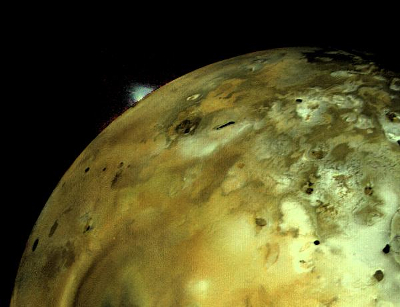Io is a moon of the planet Jupiter. It is one of the four largest moons of Jupiter, which are called the Galilean satellites. Galileo discovered these moons in January 1610. Io is slightly larger than Earth’s moon, with a colorful surface blanketed by various forms of sulfur. The same side of Io always faces Jupiter.
Io is the most volcanically active body in the Solar System. Its impressive volcanism is due to its position as the innermost Jovian moon. Io is pulled back and forth between Jupiter and two other moons, Ganymede and Europa. This gravitational tug of war causes “tides” where the solid surface bulges by about 100 meters (300 feet). The friction caused by the changing tides creates the heat that drives Io’s volcanism.

There are hundreds of volcanoes on Io. Their lava is probably comprised of molten sulfur or silicate rock. Other than Earth, it is the only known place in the solar system where volcanoes erupt extremely hot lava. Due to Io’s low gravity, plumes from large eruptions can rise up to 250 miles above the surface, at nearly half the speed required to escape Io’s gravitational field. The massive amount of volcanic activity (about 25 times that of the Earth) continually reshapes the surface of the moon.
Some of these plumes have been recorded by spacecraft. The Prometheus plume, for example, can be seen in every image ever taken of its region since 1979. It is possible that it has been continuously active since that time.
Researchers discovered in 2013 that Io's volcanoes weren't where they expected them to be, based on models of how the moon is heated. A global magma ocean beneath the surface is one possible explanation. An underground molten sea encircling the moon would allow the magma to travel far from heat sources to places where it can escape to the surface.
The magnetic field detected around Io during NASA’s Galileo mission (1989-2003) supports this theory. Io moves within Jupiter’s magnetic field, which could have sparked a magnetic field in Io as well, if it had such a magma ocean. Data suggest that Io has an iron core, which could also be the source of Io’s magnetic field.
Io also has an electric current that causes lightning in the moon’s thin atmosphere, which is mostly made up of sulfur dioxide. However, unlike the other Galilean satellites, Io has little to no water. This is likely due to its proximity to Jupiter. Heat from the massive, newly formed planet likely baked the moon, driving off its water.